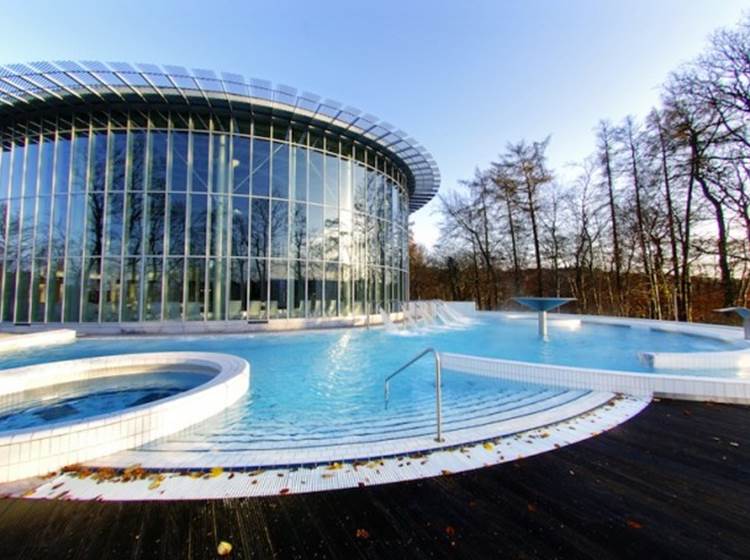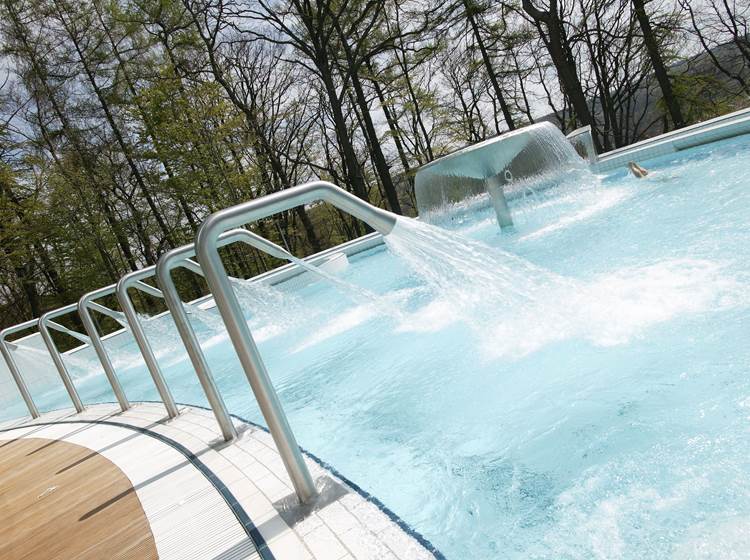THERMAL SPA
HISTORY OF SPA THERMES…
Known for its thermal waters, Spa began to take off in the 16th century when the reputation of the waters led to real trade.
At this time, it is above all the cure by ingestion of large quantities of water that prevails.
For the anecdote, the curist, called " Bobelin ", had an ivory dial on which he counted the quantity of water consumed. He also provided himself with anise or cardamon to aid in the digestion of this highly mineralized water and to help forget its taste.
Spa was the first to export its waters from the 16th century to nearby regions and then throughout Europe, thus supporting the growing reputation of its cures.
The term Spa has become a generic term for hydrotherapy in Englishand in a few other languages.
Spa having become a popular meeting place for the nobility and the European bourgeoisie, Emperor Joseph II (after his visit in 1781) nicknamed the city the "" Café of Europe "".
And it was in Spa that the first modern casino was born, La Redoute, on the initiative of the co-mayors Gérard de Leau and Lambert Xhrouet. Among the personalities who stayed at Spa, let us remember Victor Hugo, the Tsar Peter the Great, Alexandre Dumas senior, Meyerbeer.
Queen Marie-Henriette associated her name and her destiny with the city. She lived in Spa for several years and contributed to its fame.
A little later the entire Belgian royal family, notably Queen Marie-Henriette who died there in 1902. She associated her name and her destiny with the city.She lived in Spa for several years and contributed to its fame. A source essential to the life of Spa and the life of the thermal baths bears his name: the Marie-Henriette source .
Giacomo Casanova, a connoisseur of European spas, writes in Histoire de ma vie that ""Spa, […] this enclosure where, in the name of I don't know what convention, all the nations of Europe come once year in summer to do a thousand follies there; I did mine like everyone else"", adding elsewhere that ""in this hole called Spa"", under the pretext of ""taking the waters"", one rushes ""for business, for intrigues , to play, to make love, and also to spy"".
Most of the great names of the 18th century rubbed shoulders there, crowned heads and illustrious people, whether they belonged to the nobility, the clergy or the wealthy bourgeoisie.As soon as they arrived, they were registered on the ""List of Lords and Ladies"", which each year included 600 to 1,200 spa guests accompanied by their suite. These figures represent for the time a considerable influx.
Spa will not escape the upheavals and rigors of the revolutionary period. Less and less spa guests frequent the spa. To make matters worse, in August 1807, a fire ravaged the heart of the city. Spa will no longer regain the international influence of the 18th century. At the end of the 19th and beginning of the 20th century, the city underwent significant urban development with the construction of the Léopold II Gallery and the Pavilions in 1878, the Pouhon Pierre-le-Grand in 1880, the Villa Marie-Henriette in 1885 , the Lake of Warfaaz in 1892, the Church of St. Remacle consecrated in 1886 and of course the building of the Thermes in 1862 still visible today. This thermal infrastructure will be equipped with 54 equipped baths and peat baths, to open in 1868.
The City modernized the thermal establishment in 1905 but the Great War suppressed all tourist activity, transforming Spa into a vast lazaretto for the German army.
One of the most important events of the inter-war period was certainly the creation in April 1921 of the Société Spa Monopole by the Chevalier de Thier. The water trade, which had flourished until the 18th century, after having experienced a long eclipse in the 19th century, was thus to take on a real industrial dimension.
The post-war period saw the beginnings of social hydrotherapy with the inauguration of the Heures Claires in 1949. The announcement of the end of the reimbursement of thermal cures by social security at the end of the 1980s prompted the town of Spa and the Société Spa Monopole, licensee of the thermal establishment, to begin a reflection on the revival of hydrotherapy. This reflection leads shortly after to the concretization of the project of construction of a new thermal center on the hill of Annette and Lubin.
The new building housing the ""Thermes de Spa"" owes its design to the architect Strebelle, architect of Place Saint Lambert in Liège.
If since 1868 we are fond of the Thermes de Spa, it is because in this area preserved by nature, the water, present everywhere, is as if charged with the force of the earth.
The evolution of the number of curists is directly linked to the decisions taken in social matters. Thus, from more than 12,000 spa guests during the period of partial reimbursement by social security, the result fell to less than 5,000 spa guests in 1987.
The years that followed saw attendance recover little by little, but it was obvious that the thermal baths had to adapt to this new situation. The new thermal establishment opened in March 2004 and the attendance figures are rather encouraging: 54,112 visitors in 2004, 96,607 visitors in 2005, 175,000 visitors in 2015.









